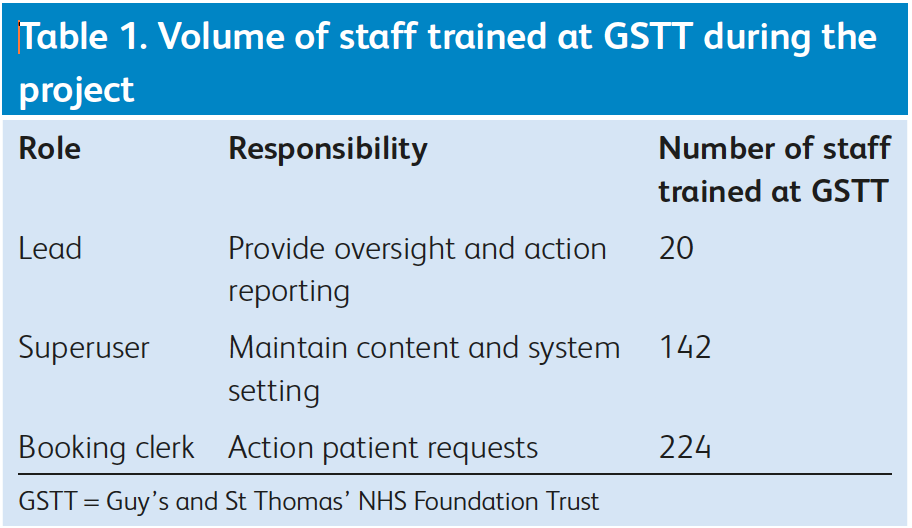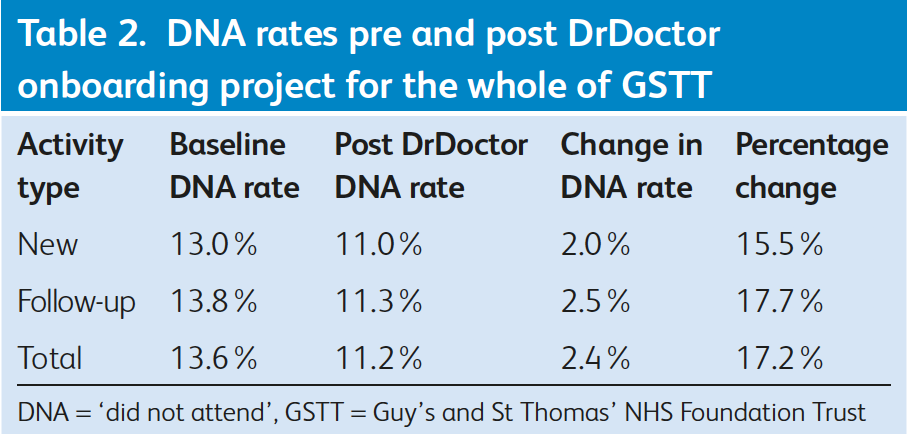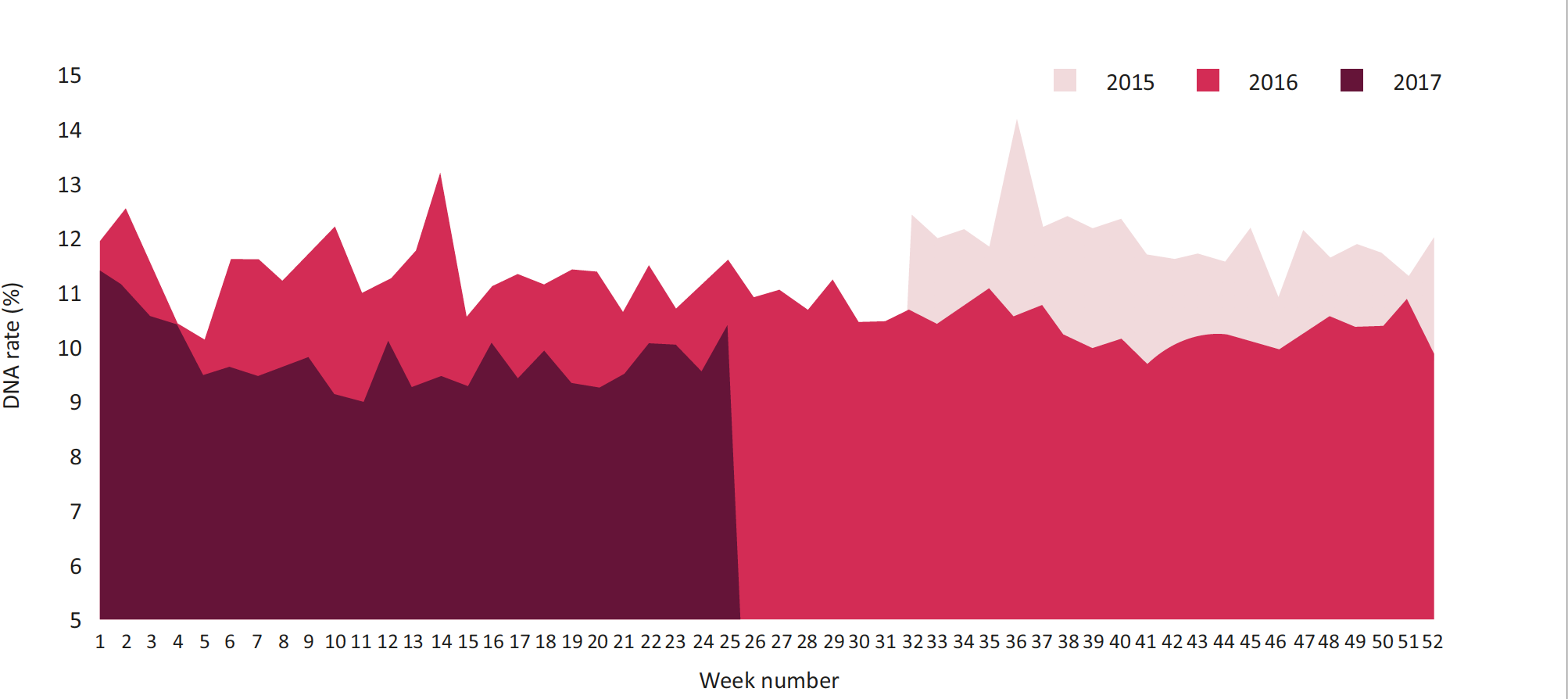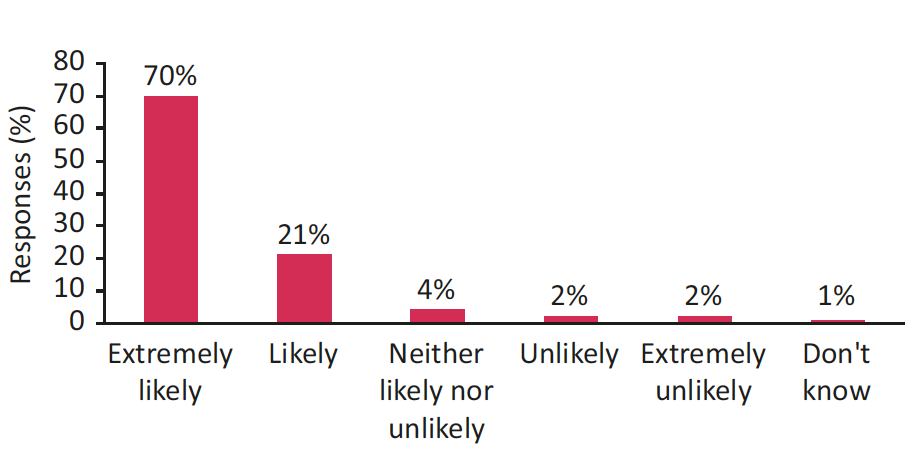Learn how together we've reduced DNA rates by 17%, generated £2.6 million in financial savings and achieved a 91% patient satisfaction rating
saved in year 1
of implementation
reduction in DNAs
Guy's and St Thomas' NHS Foundation Trust is an NHS foundation trust of the English National Health Service, one of the prestigious Shelford Group. It runs Guy's Hospital in London Bridge, St Thomas' Hospital in Waterloo, Evelina London Children's Hospital and community services in Lambeth and Southwark.
London
1,472,974
Give patients the ability to view and manage their appointments digitally
Improve attendance rates and empower patients to choose an appointment that works for them
Missed appointments represent a significant burden to healthcare budgets. The average ‘did not attend’ (DNA) rate across the NHS is 6.7%; however, significant variation can be observed. In 2015, Guy’s and St Thomas’ NHS Foundation Trust observed a DNA rate of 13.5% and partnered with Dr Doctor to reduce this by implementing their innovative outpatient scheduling and booking platform. The overall rate has reduced by 17.2%; Guy’s and St Thomas’ NHS Foundation Trust has estimated a £2.6 million financial benefit in the first year and 91% of patients would recommend the service. This case study describes the onboarding process for DrDoctor’s platform across Guy’s and St Thomas’ NHS Foundation Trust, the benefits delivered and next steps for the partnership.
NHS Digital reported between 2015 and 2016 over 7.5 million (6.7% of the total) NHS outpatient appointments were missed in England. The rate at which appointments are missed is known as the ‘did not attend’ (DNA) rate and varies greatly across hospitals and clinics. Studies have shown that the effect of missing appointments creates inefficiencies by reducing the utilisation of clinical resources, increasing referral to treatment times, and inducing stress on staff from the added pressure of trying to reduce avoidable costs. While it is difficult to establish the exact financial impact of missed appointments, the health minister Jeremy Hunt has estimated that missed hospital appointments cost the NHS up to £750 million a year. Overbooking clinics can be used to compensate for missed appointments; however, this can cause chaos on the occasions when all patients attend.
In order to reduce the effects of DNA rates, the company DrDoctor partnered with Frimley Health in 2012 to develop an innovative web-based platform to facilitate communication between hospitals and patients. Between 2012 and 2015 this platform was shared across three further trusts: Yeovil District Hospital, Nottingham University Hospital and Aneurin Bevan University Health Board.
Two months after implementation, DNA rates were reduced by 20–30% at each site. This has resulted in minimum cost savings of £1 million per site in increased efficiencies.
Guy’s and St Thomas’ NHS Foundation Trust (GSTT) have 2.3 million patient contacts each year, 1.23 million of which are planned outpatient visits. 6 In 2015 the DNA rate for new appointments at GSTT was 13.5%, double the national average of 6.7%, 7 despite using a text message reminder service. Solutions were sought to reduce this and DrDoctor was piloted between May and December 2015 in the Women’s Services directorate at GSTT, which has 2,500 outpatient appointments a month and a high DNA rate of 12.8%.
The initial results demonstrated a 34% reduction in DNAs equalling £317,000 increased revenue from activity; this led to the system being procured and implemented for all GSTT outpatient departments. The procurement process was completed in March 2016 and the project began in April 2016. The methodology and results of the GSTT project are described through the course of this paper.
The platform developed by DrDoctor enables patients to view their appointments online and access specific clinical and location information about their visit; this is supported by conversational SMS booking confirmations and reminder messages as shown in Fig 1 . Patients can use the platform or conversational SMS to reach out to their hospital and reschedule or cancel appointments if they are unable to attend. Features, content and operational parameters, eg how many times a patient is given the opportunity to reschedule, are customised to the requirements of the hospital’s internal policies and can be updated at any point. To provide the above the following steps need to be delivered as an onboarding project:
DrDoctor and GSTT planned the onboarding project to last 6 months and used PRINCE2 Agile project management structure to govern. This included regular team and board meetings run by the chief medical officer and the deputy director of operations to monitor progress and steer decision making.
To integrate with the GSTT PAS (i.PM, supplied by DXC LTD), the GSTT information technology team built data views using standardised DrDoctor schemas provided. These data views are used by DrDoctor to pull the appointment information, which is grouped by clinic code then session codes. The GSTT and DrDoctor servers within the N3 (the national broadband network for the NHS) network were linked and data were sent daily between the systems.

GSTT employs 15,000 staff and their outpatient services include 90 different specialties which are grouped into 14 different directorates. The priority list was discussed internally from analysis ordering by value of financial opportunity available (unpublished data). During onboarding GSTT staff were assigned roles as outlined in Table 1 .
The DrDoctor functionality is grouped depending on session code, which gives superusers the ability to customise patient information to this detail. During the go-live process, superusers were given the responsibility to customise and turn on features at their discretion. A reporting process was developed to notify the team of completion rates and turn off the legacy reminder system in place.


Fig 2. Weekly 'did not attend' (DNA) rates from August 2015 to July 2017 for the whole trust. The DrDoctor onboarding project started in week 14 2016 and completed week 40 2016 (post 30 September 2016). Post week 40 DNA rates have decreased by 17.2% for both new and follow-up appointments across the trust
The methodology used to assess the financial impact of the project was based on a comparison of DNA rates before, as calculated in the full business case (FBC), and after the implementation of DrDoctor at a specialty level. The DNA rate comparison was used to estimate the number of additional attendances (which would previously have been DNAs) and costs associated, using average specialty tariffs.
Integration with i.PM was successfully completed in the pre-project phase. GSTT have a total of 10,578 session codes for customisation to go-live. By the end of the project on 30 September 2016 all required staff at GSTT were trained and onboarded to use DrDoctor, and 58% of session codes had reminder functionality switched on. Challenges were encountered during training and go-live phase, reducing the amount of codes activated. These were attributable to the diversity of pre-existing operational processes and use of IT systems across the different services at GSTT.
At the end of the 6-month onboarding phase the DNA rates across the trust dropped from 11.7% to 10.4% (11.1% reduction). Table 2 shows the rates as calculated for the 2016/2017 financial year with numbers in the FBC as the baseline. A year-on-year assessment of GSTT DNA rates from 2015–17, as calculated from data sent to DrDoctor, demonstrates a decrease from an average of 12.0% in 2015 to 9.8% in 2017 (Fig 2 ).
GSTT internal reporting has calculated the 2016/17 full year equivalent financial benefit for the trust as £2.6 million. Data has also shown that one in five patients at GSTT now engage with their services digitally by following the link to their portal received in text message reminders. In response to a friends and family test about the service, of 788 responses 91% would recommend or highly recommend the service, see Fig 3.

Fig 3. Patient responses to a friends and family test about the DrDoctor appointment platform. On 30 September 2016, patients who had received a text message and used the DrDoctor service were asked how likely they were to recommend to a family or friend and for further feedback. Of the 2945 patients who were asked, 788 responded. The results above show that 91% of patients were 'extremely likely' and 'likely' to recommend the service.
The onboarding project was delivered on time, the £2.6 million financial benefit was in line with what was set out in the business case and DNA reductions were consistent with previous studies. 10 The core platform for outpatients is being managed internally by the trust with ongoing support from the company. GSTT and DrDoctor continue to work in close partnership, which allows quick feedback and development iterations that are used to continually improve and tailor the product. Superusers tailor communications to the needs of different patient populations which can add further benefits.
The trust has projected further savings of £600,000–£650,000 by increasing feature use to 80%. The capabilities have extended to cover inpatient admissions and aim to include diagnostics, to give patients a holistic view of all appointments on their DrDoctor portal. A project to roll out further automated features is being piloted in the Dental directorate and has shown promising results.
We’re not an off-the-shelf kind of company. Working with us means taking the time to understand your challenges, priorities and everything else in between.
Get in touch with one of our solutions experts to learn more about our Patient Platform.
Call us: 0330 3211 206